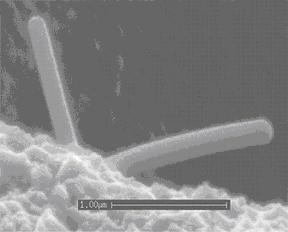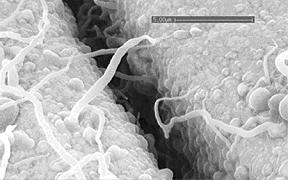| GOLD Whiskers |
|
"GOLD
WHISKERS: Introducing a New Member to the Family"
During an evaluation of thermally actuated micro-machined relays, Dr. Alexander Teverovsky (QSS Group, Inc. at NASA Goddard) observed Gold Whiskers and micro-crystallites on various gold-plated nickel structures (e.g., contacts, springs, actuators) internal to the relay package. See Dr. Teverovsky's report "GOLD WHISKERS: Introducing a New Member to the Family" for a discussion of his observations and additional images. Summary: Internal examination revealed Gold Whiskers of various size, shape, diameter, and density. Typical whiskers had lengths of several micrometers and diameters of approximately 200 nm (see Figure 1). Small, micrometer-sized whiskers with diameters from 100 nm to 400 nm were found in most of the inspected parts (see Figure 2). Figure 3 illustrates needle-like whiskers with diameters of 100 nm to 200 nm and lengths from 2 um to 4 um. Large, grass-root-like whiskers, of approximately 10 um in length and ~1 um in diameter, which were observed on several parts, are shown in Figure 4. Giant, irregularly shaped, toothpaste-like whiskers of more than 20 um in length were observed in two out of 22 inspected parts (see Figure 5). As is conventional with most kinds of metal whiskers, the reasons and conditions of their growth are NOT CLEAR. In this specific example microanalysis of the gold plating found the presence of Rubidium (Rb) in areas with high whisker density. It is possible that Rb may have played an important role in formation of the micro-crystallites and whiskers. In any case, product designers, part engineers, failure analysts, and quality assurance specialists should be aware of the possibility of formation of whiskers on gold platings. Additional References: For background information regarding the micro-relays discussed above, consult the following publications. These references DO NOT discuss the observed gold whiskers since those observations are beyond the scope of the subject papers.
|
||||

